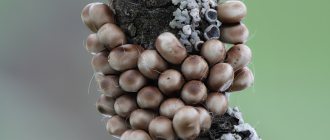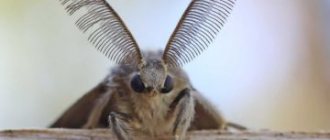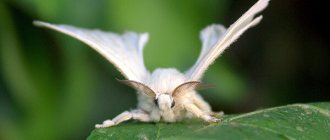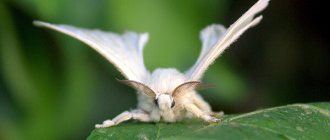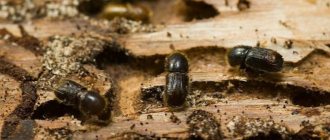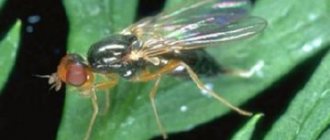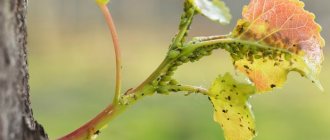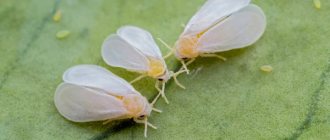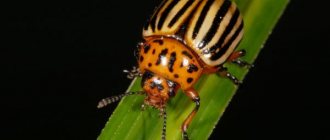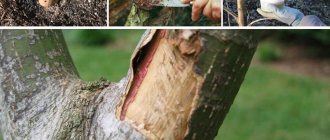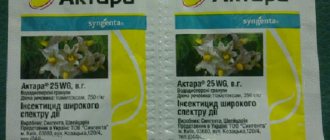Silkworm species
Unpaired
This is a nocturnal butterfly belonging to the moth family .
It is quite large in size, and the female differs significantly from the male in size, shape and color.
Thanks to this fact, the gypsy moth got its name.
The female's wingspan is about 8 cm. On her yellowish-white forewings, transverse wavy stripes of a dark brown color are clearly visible. The female's legs and antennae are black, and her thick abdomen is grayish-brown. Its tip is very pubescent.
The male gypsy moth can be identified by its unusual dark gray antennae, shaped like feathers. The span of its yellow-gray wings reaches no more than 4.5 cm. Wide stripes and spots of a darker color are visible on the front wings. The male's abdomen is thin with a brush of hairs at the tip.
Help - Thanks to the unusual structure of the antennae, the male gypsy moth butterfly is able to locate the female 11 km away!
The butterfly eggs are colored first yellow and then pinkish-white. Their shape is round and slightly flattened, and their diameter is no more than 1.2 mm. The hairy, brownish-gray caterpillars are distinguished by the fact that on their backs there are 11 pairs of red and blue warts, each of which is covered with a tuft of hair. The size of the caterpillars reaches 7.5 cm.
The gypsy moth overwinters in the egg stage . In early spring, caterpillars are born from them, which, crawling through the trees, begin to actively feed on buds, leaves, buds and flowers. Thanks to their hairiness and with the help of the wind, caterpillars are able to cover distances of about 12 km in search of food. They feed intensively for two months, and then weave cocoons in cracks in the bark or between leaves and pupate.
After two weeks in July-August, butterflies hatch from the cocoons. After mating, they lay eggs on the bark of tree trunks, stumps, among stones and at the bottom of fences.
The butterfly mixes the eggs with grayish fluff, as a result of which the clutches look like yellowish-gray pads up to 3 cm in diameter, completely covered with hairs.
Females are very fertile and are capable of laying up to 1200 eggs, several hundred in each clutch. It is worth saying that gypsy moth eggs are very hardy and survive the winter well at low temperatures .
Photo
Now you can look at the gypsy moth in the photo:
Ringed
This is a small beige butterfly from the cocoon moth family with a wingspan of no more than 4 cm. There is a dark stripe on the front wings. The eggs of the butterfly are lead-gray and cylindrical in shape. The color of the caterpillar's cover is gray-blue with a clearly defined white line along the middle of the back and orange and black-blue on the sides. The caterpillar is about 6 cm long. It is densely covered with short, velvety, as well as long, sparse hairs.
The female ringed silkworm lays up to 400 eggs around shoots, twigs or leaf petioles. The masonry looks like a wide ring encircling the shoot. It is for this characteristic form of oviposition that the ringed silkworm gets its name.
Caterpillars emerge from the eggs remaining to overwinter in the spring when the buds swell. While actively feeding, they go through 5 stages of molting. Caterpillars usually eat at night and live in colonies , during the day accumulating in the forks of thick branches and making nests there woven from cobwebs. After about 45 days in early June, the caterpillars move into the rolled leaves, entwine them into a strong cocoon, climb inside and turn into a pupa. After a couple of weeks, a butterfly flies out of the cocoon.
Photo
Rezucha mosaic virus
The disease, caused by a virus and spread by nematodes, manifests itself in the fact that recently rooted honeysuckle seedlings have sharply shortened internodes, and uncontrolled growth of lateral shoots from axillary buds begins. The foliage does not develop, the plants wither and die.
Measures to combat this honeysuckle disease include careful selection of planting material, as well as the mandatory destruction of shrubs with signs of the disease.
If honeysuckle shoots were damaged by frost in winter, they must be cut out in a timely manner, otherwise the same fungi quickly settle and develop on the wound surface, causing the shoots to dry out and leaves to fall off.
Geographical distribution
The habitat of the gypsy moth is all of Europe to the southern regions of Finland and Scandinavia, as well as North America, North Africa, Japan and the countries of Asia Minor.
In Russia, the pest is widespread in the south and throughout the territory where oak grows.
It is also found in Siberia, the Baikal region (55–57° north latitude), and the Far East.
The ringed silkworm is distributed in Europe, with the exception of the Far North, in South and North Korea, Japan, and northern China. In Russia, it lives in the Far East and Siberia.
Damage caused
In some cases, the population collapses because the caterpillars starve, either because the trees become completely defoliated before the caterpillars are fully grown, or because the quality of the host's leaves declines. Defoliated trees usually recover from caterpillar attacks and do not suffer fatal damage. However, in some cases, trees or parts of trees may be killed after several seasons of repeated defoliation. This occurs when the caterpillars attack trees that are already stressed due to drought.
Why are they dangerous?
Both species are pests of both deciduous and fruit crops (read about other pests of apple trees and other fruit trees in a separate article). They can harm more than 300 species of trees. Among fruit crops, the gypsy moth prefers cherry, plum, pear and apple trees, while the ringed moth prefers only apple trees. .
It is the caterpillars that pose a danger to the garden, as they feed on leaves, young buds and flowers.
One silkworm caterpillar can eat up to 30 young leaves during its two months of development. In case of mass accumulation and without timely protective measures, voracious pests leave the tree completely without foliage. As a result, the plant dries out and dies. Five or six clutches of silkworm eggs on one tree are a serious threat to it.
Causing harm
Only the bright, striped caterpillars of the ringed cocoon moth cause harm. They feed on leaves, and a decrease in the amount of greenery on the tree introduces an imbalance in the harmonious exchange of nutrients in the plant, including disruption of photosynthesis, which is vital for it. Sometimes a population of caterpillars is capable of destroying entire young shoots. As a result, the tree weakens, stops blooming and does not bear fruit.
In order to prevent negative consequences for the garden, you need to start fighting ringed silkworms at the very beginning of spring. A careful inspection of trees, searching for and then destroying nests will help you notice a dangerous pest in time.
Prevention and control of gypsy moth
The fight against silkworms begins with regular inspection of the apple tree and other fruit trees in the fall and early spring.
Detected ovipositions are carefully collected and burned. They can also be buried half a meter deep in the ground.
The shoots with spiral clutches of the ringed silkworm are cut out and also burned.
The hatched caterpillars are collected by hand . The young generation of ringed silkworms can easily be found on the forks of branches in the morning. Glue traps attached to the bottom of the trunk also They prevent the spread of pests from clutches located at the roots.
Help - When collecting caterpillars, it is advisable to wear gloves on your hands, since the hair of insects is poisonous and can cause an allergic reaction.
In case of a massive attack of gypsy moth, trees are sprayed with insecticides such as Antio, Zolon, Karbofos, Metathion or Phosfamide . Treatments are carried out during the period when the caterpillars rise into the crown and at the end of their migration. It is not recommended to treat trees during flowering, because chemicals can harm beneficial pollinating insects.
The following biological products are also used against the pest: “Lepidocide”, “Dendrobacillin”, “Entobacterin”, “Bitoxibacilin” . They spray trees when caterpillars appear. After a week, the treatment is repeated.
The use of biological products requires certain conditions : air temperature from 18 to 25 ° C, and humidity - at least 60%.
In the summer, during the setting and ripening of fruits, it is better to use harmless folk methods to combat silkworms. A saturated solution of pine concentrate (4 tablespoons per 10 liters of water) effectively repels pests. Trees can be sprayed with this solution several times. Caterpillars are also afraid of infusions of wormwood, rotted hay, tomato tops, and mustard.
Pests that have made their way into the crown can be knocked off the tree with a strong stream of water , collected from the ground and destroyed. Natural enemies of insects - birds - also effectively save trees from caterpillars. To attract birds to the garden, it is necessary to place several birdhouses on the site .
As you can see, gypsy and ringed silkworms are capable of causing great damage to an orchard. To cope with pests or even prevent their spread, it is important to recognize the danger in a timely manner and take all necessary measures.
How to protect your garden from numerous dangerous insect pests that can destroy the entire harvest? To get rid of the insidious enemies of the garden, it is important to take all necessary measures in a timely manner. Read in our separate publications about the most dangerous and insidious pests of apple trees: sapwood beetles, hawthorn butterflies, apple and oriental codling moths, as well as leaf miners.
What damages the ringed cocoon moth?
The ringed cocoon moth is a pest that loves warm weather, and even better if the tree is in the sun.
First of all, the ringed cocoon moth damages fruit trees: apple trees, plums, pears, but if there is a lack of fruit trees, it easily and quickly spreads to oak, birch, poplar and shrubs (for example, blackthorn).
In nature, ringed cocoon moth butterflies appear in June and July. During the day, butterflies sit on trunks, while mass reproduction occurs on walls and fences with roof-like wings.
Ringed cocoon moth butterflies fly in the evening. Large and heavier females are less mobile; males fly rapidly, like other cocoon moths, and often fly towards light sources . By the way, it is electric traps that are effective in the fight against ringed cocoon moths, as a preventive measure.
The female begins laying eggs about a week after mating. Females lay eggs in a ring around thin one- or two-year-old twigs. Sometimes the ring is incomplete, unclosed or partial.
One full ring contains 150-400 eggs, which are tightly connected in rows. On average, a female lays about 300 eggs. The eggs overwinter in diapause. Caterpillars of the ringed cocoon moth hatch only in the spring of next year .
In April and May, from the overwintered eggs of the ringed cocoon moth, caterpillars hatch within 2-3 days, which immediately rise up into the crowns to the blossoming branches.
If the weather is cold and leaf opening is delayed, ringed cocoon moth caterpillars wrap themselves in dense cocoons, where they can lie in a daze for up to 6 weeks without food.
Caterpillars, falling on budding leaves or flowers, eat them up, forming a nest of cobwebs between the branches . After prolonged feeding on warm sunny days without precipitation, the caterpillars grow very intensively, spread out and eat leaves in the crowns.
Caterpillars of the ringed cocoon moth are characterized by “quivering” movements of the front part of the body. Only in rainy weather and during molting do they crawl into the forks of branches or to the base of a branch near the trunk, where they spend a short time in a web nest without food and without movement.
The entire development period of caterpillars from hatching to pupation lasts 38-41 days . Adult caterpillars pupate in June in yellow-white cocoons, most often in cracks in the bark or walls, sometimes among already eaten leaves entangled in a web, and in exceptional cases on the ground in the forest floor. Sometimes several cocoons are connected together.
A new generation of ringed cocoon moth butterflies appears at the end of June, and the majority appear in July. The female lays eggs a short time after mating.
The ringed cocoon moth is a pest that prefers warm climates. Therefore, in the southern regions of Europe, outbreaks of mass reproduction occasionally occur in relatively large areas of oak plantations, mainly in hornbeam-oak forests.
In damaged oak stands, these two types of caterpillars completely eat the leaves, resulting in loss of growth and loss of seed yield. Disastrous outbreaks of mass reproduction, in which the ringed cocoon moth has its share, lead to complete devouring, and often to the death of oak plantations.
The ringed cocoon moth causes great harm in the northern regions of Russia, where outbreaks of mass reproduction also occur from time to time. Large areas of especially thinned deciduous forests, gardens and shelterbelts are captured. In the Far East, mass reproduction occurs in lowland elm forests with shrubby undergrowth.
Polyphagous caterpillars damage all rosaceous fruit crops in gardens and parks, especially apple and plum trees, as well as forest species: oak, elm, birch, willow, etc., preferring oak . Found on black currants and raspberries, forced feeding on soybeans and vegetable crops was noted: potatoes, cabbage, carrots.
Since the mid-80s, the species has been recorded in various areas of the Moscow region and adjacent areas of neighboring regions, where it is quite common, but nowhere is it numerous. Until recently, the species was also often found, sometimes in large numbers, in forest parks, forest belts, gardens and squares in various districts of Moscow.
The ringed cocoon moth is distributed throughout Western Europe, Asia Minor, China, Korea, Japan, the Baltics, Belarus, Ukraine, Moldova, Transcaucasia, northwestern Kazakhstan, Central Asia, the Urals, and also in the Crimea
In Russia, the ringed cocoon moth is distributed in the European part, to the north to St. Petersburg-Ekaterinburg, in the south of Siberia and the Far East, including about. Sakhalin, o. Kunashir. The subspecies M. testaceum Motsch has been isolated for the Far East. Also known as a pest in northern China, Korea and Japan.
HOW TO FIGHT THE RINGED SILKWORTH?
So, the fight against the butterfly begins immediately with the onset of spring. The first step will be the mechanical removal of egg clutches, and then caterpillars:
- First you need to carefully examine the trees on the site. If masonry is found that has ringed a branch, then it must be completely cut off. Later, the leaves on which the striped butterfly larvae feed are also destroyed.
- Branches cut along with pest eggs must be destroyed as soon as possible by burning. Simply throwing them away will not be enough: the caterpillars will still be born, and then with a high degree of probability they will move to neighboring trees in search of food.
- All cobwebs must be removed from the tree.
These simple measures, if they do not completely save you from ringed cocoon moth caterpillars, will certainly reduce their number in the future, so you should not neglect mechanical removal.
Insecticides
Chemical insecticides show the best results in the fight against silkworm caterpillars. But their use is justified only in cases of catastrophic infection, because toxic drugs destroy beneficial insects, thereby disrupting the harmony in the garden.
Insecticides will be needed if:
- at the moment of swelling of the buds, 3 clutches were found;
- after the leaves appear, 10% of them are chewed;
- When most branches are shaken, 1–2 caterpillars or more fall to the ground.
It is rational to spray as early as possible, preferably at the very beginning of spring, while the buds have not yet blossomed. So most of the larvae in the eggs will be dead.
For treatment by spraying use:
- organophosphorus compounds (OPCs) - usually used on an industrial scale;
- neonicotinoids: “Aktara”, “Calypso”, “Taboo”, etc.
- pyrethroids.
Any toxic preparations to combat insects must be used in full accordance with the instructions for use.
Biological methods
The biological preparations “Bitoxibacillin” and “Lepidocid” are effective against already hatched caterpillars. Their main advantages are their impact only on pests and safety (for both garden inhabitants and humans). These drugs work when the air temperature rises above 15 °C.
Folk remedies
Gardeners use 3 unconventional ways to combat caterpillars:
- Creation of special traps. The principle is that caterpillars often prefer to come down to the ground during the day. Therefore, the tree trunk is wrapped with a piece of fabric, secured with a rope in such a way as to form a lapel. During the day, caterpillars are collected from it using gloves, because they can cause allergies. A cloth smeared with sticky Vaseline can also serve as a substitute for a trap: it will be impossible for the larvae to get out of it.
- Destruction of masonry by coating them with kerosene immediately after discovery.
- Attracting birds to the site that will happily feast on bright caterpillars: installing birdhouses and feeders in the garden.
These methods are good when there are few eggs or caterpillars on the tree.
To expel the ringed silkworm from a site, you need to start fighting its clutches immediately after winter. If there are too many eggs, then you cannot do without using insecticides and chemicals.
In areas of currants and gooseberries
During budding, currants and gooseberries can be damaged by aphid larvae emerging from overwintered eggs on the bark of branches, and in some cases by spider mites, the females of which overwinter under fallen leaves and lumps of soil, under currant and gooseberry bushes. Emulsions of karbofos and trichlorometaphos-3 (30 and 20 g per 10 liters of water) are effective against these pests. Spraying, if necessary, is best done when the first leaves begin to emerge from the buds, in which the pests are concentrated.
In areas where the fungal disease goblet rust is widespread and where this disease is especially harmful, it is advisable to spray currants and gooseberries with 1% Bordeaux mixture or fungicides replacing it during bud break and again when buds separate.
The emergence of gooseberry moth butterflies from pupae and their crawling out of the soil coincides in time with the beginning of the appearance of black currant buds. Somewhat later, female moths begin to lay eggs, usually inside flowers. In total, the butterfly can lay up to 200 eggs. The emerging caterpillars are very voracious: each of them during its life can destroy (eat seeds and pulp and entangle in cobwebs) up to 6 gooseberries or up to 15 black or red currants.
In the event of a massive appearance of caterpillars, which is determined by the degree of damage they caused to berries in the past year (if the moth damaged 5-10% of the berries, then massive damage can be expected this year), before flowering, currants and gooseberries are sprayed with a solution of chlorophos (20 g per 10 l water). If there is a likelihood of the appearance of leaf and other types of gall midges - very small mosquitoes, the larvae of which damage the leaves, shoots and flowers of black currants, the soil where the gall midges overwinter is also sprayed with chlorophos solution.
By the time blackcurrants budding, currant bud mites begin to crawl out of damaged buds to penetrate new buds on young shoots. The emergence of mites continues for more than a month and a suspension of colloidal sulfur (50-100 g per 10 liters of water) is used to combat them. It is advisable to add karbofos (20 g per 10 l) to the suspension to destroy aphids, mites and other pests. Sulfur preparations can cause leaf fall on some varieties of gooseberries, so when spraying black currants, do not allow the sulfur solution to get on the gooseberry bushes.
Insecticides
Chemical control methods allow you to get the desired result within a few days. A broad-spectrum poison destroys butterflies within the first 2 hours after spraying plants, and caterpillars – up to 30 days. Initially, the poison enters the body by contact through the chitinous cover. It affects the functioning of the nervous system, causing muscle paralysis and death.
Within 2 hours the active toxic substance enters the sap of the plant, silkworm caterpillars on the apple tree and other plants die while feeding. Mass deaths occur within a few days.
It is recommended to use an insecticidal agent against silkworms on fruit trees twice a season. A single treatment in early spring is allowed. Spraying the trunk in the fall is ineffective because the poison does not affect the eggs.
Gardeners call the best drugs Actellik, Aktara, Karbofos, Fufnon. The poison is used in exceptional cases, if other control methods do not help.
Goldentail
The moth is snow-white in color with a golden tuft of dense hairs at the end of the abdomen. Its caterpillar has a grayish-black color, against which chains of red convex pimples with tufts of brown hairs protruding from them stand out sharply, and at the end of the body there are two large orange spots. Caterpillars overwinter in a ball in nests, as if woven from 5-7 leaves hanging on a tree.
Control measures
Promptly remove and destroy caterpillar nests from trees. In the spring, crawling caterpillars can be much more difficult to overcome. In the spring, after the buds open, insecticides are sprayed against the caterpillars emerging from the cocoons. Spraying is repeated at the end of summer during the hatching period of young caterpillars.
Food
An adult beetle, or, if correctly, a butterfly, starves throughout its entire life, since it does not have a mouth opening. But the wild stream of caterpillars is very dangerous, as they are extremely voracious. They feed during the day, migrating within the crown. But older individuals feed at night and love warm weather
Depending on the place of residence, the diet also changes, which is why the following types are distinguished:
- ringed silkworm;
- pine silkworm;
- birch silkworm;
- oak silkworm;
- traveling silkworm;
The oak silkworm has become widespread in Europe, the Caucasus, the Far East, and in the Carpathian and Crimean mountain forests. Since oaks, beeches, and hornbeams are often found in this area.
Gypsy moth caterpillar
Birch and pine silkworms live in Siberia, namely in its forest-steppe and small-leaved forests, in the Ural and Sayan mountains, Altai Territory, and Central Asia.
Tips for effective pest control
The fight against silkworms in a summer cottage should be comprehensive. In one season, caterpillars can destroy young garden trees and significantly reduce the yield of already formed plants.
- On young trees, caterpillars can be collected by hand and then destroyed. Clutches of eggs are scraped off the bark, trampled or burned.
- Attract natural enemies of the gypsy moth - birds - to your site. Cuckoos, woodpeckers, finches, orioles, jays, and titmice help fight gypsy moth caterpillars. They build feeders and hang them on trees.
- In March, as soon as the snow melts, treat the tree trunks with lime or apply adhesive belts. Such a barrier prevents the movement of gypsy moth caterpillars up to the crown and does not allow pests to develop. To make a belt, petroleum, resin, machine oil, adhesive tape, and special preparations in the form of a gel consistency against harmful insects are used.
- At the beginning of the migration of caterpillars to the tree crowns - in April, even before the buds open, the apple tree and other trees are treated with biological preparations or insecticides. During flowering, folk methods are used to combat gypsy moths on apple, pear, plum and other garden plants.
You can get rid of gypsy moths in your summer cottage in one season, if you put maximum effort into it and combine several methods of influence.
A sign of tree infection is the presence of small holes on the leaves or significant deformations, as well as cobwebs.
Other types of silkworms are also common in Russia:
The caterpillars of all these silkworm species are protected by bristles and can cause skin irritation if picked with bare hands.
Protecting trees from rodents
Mice, voles and other mouse-like rodents damage the roots of fruit plants and damage tree branches and trunks. These small pests overwinter in piles of plant debris, so you need to keep your garden clean and dig up the soil regularly. The catching belts we wrote about above will also help protect trees from rodents. Another way is to tightly cover the bases of the trunks with spruce branches (spruce branches) in the fall so that the needles “look” down. The cover is removed in the spring, after the snow has melted.
In winter, the tree trunks need to be trampled down so that mice cannot get to the bark. This must be done after heavy snowfalls, especially if the snow level has exceeded the strapping area.
Take care to protect your garden in the fall, and then you won't have to fight pests with redoubled zeal in the spring. To properly prepare for the end of the season, read our material:
Truth born in dispute
Once, during a lesson on the surrounding world, a dispute broke out between students about the dangers and benefits of butterflies.
In this discussion, Sasha Tokarev defended lepidoptera and began to look for confirmation of his opinion. The result of the boy’s search was his work entitled “Is a butterfly useful or not? I really want to find the answer!” Here are excerpts from this work. I think it will be useful to those who grow vegetables and fruits on their plot and are interested in an environmentally friendly harvest. “I really like insects. But especially butterflies. In the summer at the dacha, I heard my grandmother scolding butterflies, saying that they do so much harm to her garden! But I thought that such beauties could not be harmful.
At school, during a lesson on the surrounding world, we talked about how we spent the summer, where we vacationed, and what we saw. I asked Olga Ivanovna: “Is it true that butterflies are harmful?” And we argued with other students. I began to look for the answer to my question in books, in children's encyclopedias, in museums, on the Internet with the help of my mother.
Then the whole family visited the Darwin Museum, and I was surprised how many different butterflies there are in the world! I wondered how such beauties could harm a person. To the Zoological Museum of Moscow University. M.V. I went to Lomonosov with my classmates.
On the way to the museum, I asked each of the guys three questions: 1. Do you think all butterflies are equally useful?2. Do butterflies harm agriculture, meadows, forests?3. Do you know about beneficial butterflies?
It turned out that not all the guys know about butterflies and their role in human life. Therefore, my work, which I prepared with the help of parents and teachers, will be interesting and useful to many.”
While working on his childish, but very real scientific research, Sasha learned a lot of new interesting information. Perhaps the useful advice (on how to deal with different types of butterflies that live in the garden), which parents and teachers helped the inquisitive boy formulate, will be a good help to all summer residents.
Development
Females lay eggs in depressions in the bark of trunks and stumps, releasing them in groups of several hundred pieces, and mix them with yellowish-gray fluff that also covers them on top. Having laid eggs, the female may die immediately. Heaps of eggs sometimes cover the bases of trunks with continuous fluffy rings and are then found on stones, buildings, etc. The eggs overwinter and tolerate moisture and cold without losing their viability even after a 10-day stay under water. Rainy weather during the flight of butterflies interferes with their mating, and then the females lay mostly unfertilized eggs, from which caterpillars do not develop.
The caterpillars hatch in early spring: they are covered with disproportionately long and numerous hairs, equipped with special extensions or swellings, thanks to which they are easily picked up by the wind.
Starting from June - mid-July, depending on the temperature, pupation occurs. The pupae are attached by a network of numerous cobweb threads, being placed low from the ground in crevices of the bark, on the lower branches, sometimes between half-eaten leaves covered with cobwebs. After 10-15 days, the flight of butterflies begins.
Winged pests in garden beds
Vegetables occupy a significant place in the human diet. The balance of our diet depends on their quality and quantity. And any summer resident always wants to get rid of butterflies in the garden in order to preserve the harvest in full.
Fall armyworm
With the onset of dusk, the active summer of the winter armyworm begins. To lay eggs, dark brown females choose plants in open spaces; butterfly clutches can be found on strawberries. During a season, one individual can lay up to 2000 eggs (10-30 eggs in one place).
The development of caterpillars takes 24-30 days, after which they burrow into the ground. By digging a depression up to 6 cm, they pupate. The second generation caterpillars also overwinter in the ground (up to 20-25 cm). After the soil warms up, they rise to the surface of the earth. Mass emergence of butterflies is observed in May.
Acacia moth (legume)
A light yellow butterfly with medium-sized fore wings (span - 25-30 mm), the hind wings are grayish in color. The female moth lays 100-600 greenish-yellow eggs. In 110-120 days of life, the acacia moth manages to make 2-3 clutches. After 4-21 days (depending on the generation), caterpillars with pink bodies and a yellow shield appear.
Depending on the air temperature and nutrition, the caterpillars develop within 20-40 days. Pupation occurs on the ground, sometimes caterpillars form cocoons at a depth of 2-5 cm, strengthening them with particles of earth. Moth moths appear after 12-15 days.
Onion moth
A small butterfly of light gray or chocolate color with wings measuring 11-15 mm. The female lays 60-80 eggs in the area of the neck of the onion or on shoots. A week later, caterpillars appear, eating the inside of the onion.
After 15-20 days, pupation begins. During the growing season, usually 2-3 generations have time to mature. The age of onion moths is observed after 10-20 days.
Cabbage scoop
The spotted gray-brown wings of the cabbage cutworm reach a span of 35-60 mm. It flies mainly at night. At the same time, the female lays 40-60 (up to 700 per season) eggs.
Adult caterpillars (body size up to 25-30 mm) are ready for pupation. They make cocoons by burrowing 8-10 cm into the ground. In the spring, the butterfly flight begins.
Cabbage moth
The sickle-winged butterfly with wings of 15-18 mm causes great damage to field crops. The light brown female lays 100-300 eggs, grouping them in groups of 4-5. A week later, caterpillars appear, which molt 3-4 times during their development. In search of fresh greens, they can crawl into beds with radishes.
Adult caterpillars (body length - 11 mm) pupate, attaching a cocoon to the back of the leaf. The moth's flight begins in 35-40 days. During the summer season, (depending on the climate) from 2 to 10 generations of cabbage moths can develop.
Cabbage white (cabbage)
Large butterflies with powdery white wings (span up to 60 mm) and dark rims along the edges. The females have large black spots on their wings. Female individuals lay 100-300 ribbed, lemon-yellow eggs.
The voracious caterpillars appear on days 6-8; they often crawl onto neighboring plants. Before the butterflies emerge, they remain in the chrysalis for 8-17 days. During the summer season, 2-4 generations of cabbage may appear.
exclamation scoop
A large butterfly (body length 30-40 mm) with large brown-brown wings (span 32-45 mm). The color of the male is lighter - from yellow-brown to gray-yellow. At the top of the wings there are two round black spots, at the base there are wedge-shaped wide stripes, the outlines of which resemble an exclamation mark.
The female lays eggs on fallen leaves. The eggs are ribbed, translucent with a greenish tint (diameter 0.7-0.9 mm). After 12-14 days, yellowish-white caterpillars appear (the length of an adult is 30-40 mm). Over time they turn red. A black stripe stretches along the back, which forms small triangles on each segment of the caterpillar's body.
Yellow-brown pupae (cocoon length - 12-14 mm) are equipped with sharp spines, and there are two tubercles on the sides. They overwinter in fallen leaves or in the surface layers of the soil. The adult caterpillars (4th-5th generation) remaining for the winter can go deeper into the surface layers of the soil (up to 10 cm); the butterfly flight begins at the end of May.
Description of butterflies
Appearance
Adult insects look somewhat awkward compared to other butterflies.
The reason is a more massive abdomen, a large head, shaggy legs, comb-like antennae and relatively small rounded wings, which the moths fold in the form of a cloak, pushing the upper wings flat onto the lower ones. The wingspan is from 18 to 90 mm. Most species of mothworts are dimorphic—females and males differ greatly.
The color of the wings is most often one-color; the front wings may have a pattern. Some types of butterflies do not have wings. There are hair-like scales on the chest and abdomen. The ridges of the double-combed antennae in males are significantly higher than in females. Labial palps are well developed. But the proboscis is underdeveloped or completely absent.
Reproduction
Most moths are active at dusk or at night. The fertilized female lays 2–3
hundreds of eggs, from which caterpillars emerge after some time. The caterpillars develop, overwinter and pupate by the beginning of next summer. The pupa differs from other types of butterflies in that it is covered with hairs. After about 10 days, a butterfly emerges from the cocoon. Under unfavorable conditions, the eggs overwinter and the caterpillars hatch in the spring of next year. Most often, Volyanki produce one generation per year. Some species in the south can produce two generations of insects.
The reproduction of the steppe brushtail is interesting. The legless and wingless female remains in the cocoon for the rest of her life. The winged male, having found the cocoon, breaks through it and, having penetrated inside, mates with the female. After 9 days, the caterpillars emerge from the laid eggs and, having eaten the mother’s body, crawl out of the cocoon.
Inpatient surveillance, inpatient surveys, follow-up surveys and detailed surveys
are made in the fall after the leaves have fallen using the method of model trees and three model branches. Oviposition of the ringed silkworm is found on the cut branches. They are cut together with branches from all three branches, the average number per branch is calculated, and according to the number of branches on the model tree, they are listed for the tree as a whole.
The cut branches are dried for several days, having previously cut the branch near the oviposition itself, after which the oviposition is easily and completely removed from the branch. After weighing them, the average weight of one oviposition is calculated. Then the largest and smallest ovipositions are weighed separately and the number of testicles in them is determined by their weight.
Quality indicators are judged by the following data for the ringed silkworm: the weight of healthy female pupae varies from 0.18 to 0.85 g, the weight of ovipositions varies from 0.005 to 0.20 g, the number of testicles in them varies from 15 to 500. According to the phases of the outbreak the same indicators vary within the following limits.
In the first and second phases of the outbreak, the maximum weight of pupae is 0.80 - 0.85 grams, with an average weight of 0.60 - 0.70 g. The maximum weight of oviposition is 0.18 - 0.20 g, with an average weight of 0.12 – 0.14 g. The number of testicles in oviposition is 450–500 and 300–350, respectively.
In the third phase of the outbreak, the average weight of pupae is 0.50 - 0.55 g. The average weight of oviposition is 0.08 - 0.10 g, with 200 - 250 eggs in them.
The collected testicles are analyzed for parasites, diseases and infertility. It is easier instead to keep them in a box in the air until January-February, and then bring them indoors, remove both caterpillars and parasites from them, count both, establish the percentage of parasites that have flown out, the percentage of healthy (emerging from the testes) caterpillars according to in relation to the total number of testicles, and by the number missing up to 100%, judge the mortality caused by diseases, predators and infertility.
The ringed silkworm flies well under the light of even simple lamps, so light traps can be used for censuses.
The surface of the cylinder C formed by the oviposition can be calculated using the formula C = VDp, where B is the height of the oviposition in mm, D is its diameter, measured along the outer edge, in mm; the value of n is 3.14. When calculating, replace 3.14 with 7, since preliminary calculations showed that there are 7 testicles on an area of 3.14 mm of the oviposition surface.
Males are good at following the scent of females, so sex traps can be used to count butterflies during the summer. Threat indicators for light and sex traps for ringed silkworms have not been established. As a support, you can take those indicated for the lacewing.
